A good chew toy can be a dog's best friend. It provides crucial mental stimulation, helps keep teeth clean, and satisfies the natural urge to chew. As dedicated pet owners, we often grab toys based on durability or how much fun our dogs might have with them. However, it's vital to consider the safety of the materials they are made from. Unlike toys made for children, pet toys do not have the same rigorous safety standards, which can leave a gap in consumer protection and potentially expose our pets to harm.
This lack of regulation means some products available on store shelves could contain materials that are harmful to your pet. Understanding the potential hazards hidden in your dog’s favorite toy is a key part of responsible pet ownership. The team at Coolidge Veterinary Hospital is dedicated to providing the information you need to keep your companion happy, healthy, and safe during playtime.
Hidden Dangers Lurking in Common Chew Toys
When selecting a toy, it’s important to look beyond the bright colors and fun shapes. Certain materials and design flaws can present significant risks, from toxic chemical exposure to serious physical injury that could require an emergency visit.
1. The Problem with Plastics and Harmful Chemicals
Many of the most popular dog toys are made from plastic, rubber, or vinyl. While many of these are perfectly safe, some can contain chemicals that leach out as your dog chews. Over time, ingestion of these substances can contribute to health problems.
- BPA and Phthalates: These chemical additives are often used to make plastics more flexible and durable. Phthalates, in particular, are common in soft vinyl toys. Studies have linked these chemicals to endocrine disruption, which can interfere with your pet's hormonal systems. While pet products are not required to be labeled as "BPA-free" or "phthalate-free," reputable manufacturers often provide this information voluntarily to signal their commitment to safety.
- Heavy Metals: Cheaply made toys, especially those imported from countries with less stringent manufacturing oversight, may contain toxic heavy metals like lead, cadmium, or chromium in the paint or plastic itself. If a dog ingests fragments of a toy containing lead, it can lead to severe poisoning that affects the nervous system, gastrointestinal tract, and other vital organs.
To reduce these risks, choose toys from trusted brands known for their commitment to safety. Look for products made from food-grade, natural rubber or those clearly labeled as "non-toxic."
2. Physical Hazards from Poorly Constructed Toys
Beyond chemical toxicity, the physical construction of a toy can make it a serious hazard, especially for a powerful chewer. A poorly made toy that breaks apart can quickly turn into a veterinary emergency.
- Small, Ingestible Parts: Toys designed with small, attached pieces like plastic eyes, bells, or squeakers can be a major risk. A determined dog can easily tear these parts off and swallow them, which can cause a life-threatening intestinal blockage requiring emergency surgery.
- Strings and Rope Fibers: Rope toys are excellent for interactive games of tug, but they should be used with supervision. If your dog likes to sit and chew on them, they can ingest the small fibers. These strings can lead to a linear foreign body obstruction—a dangerous condition where the string can cause the intestines to bunch up, cutting off blood supply and requiring immediate medical intervention.
Always supervise your dog during play, especially with new toys. Inspect their toys regularly for any signs of fraying, cracking, or breaking. If a toy is damaged, it's safest to throw it away. Should you ever face a pet emergency, the experienced team at Coolidge Veterinary Hospital is here to provide urgent care.
3. The Risks of "Edible" and Overly Hard Chews
Many owners provide edible chews or hard bones to keep their dogs occupied for long periods. While popular, these options come with their own set of potential problems that every owner should be aware of.
- Rawhide and Digestible Chews: Dogs love rawhide, but these chews can pose a choking hazard if a large piece is broken off and swallowed. Furthermore, they can cause blockages in the esophagus or intestines because they do not break down easily.
- Hard Chews Like Bones, Antlers, and Nylon: Toys that are too hard for your dog’s teeth can cause painful and costly dental damage. A good rule of thumb is the "thumbnail test": if you cannot make an indentation on the toy's surface with your thumbnail, it is likely too hard and could fracture a tooth.
Instead, look for chew toys made from durable yet flexible materials, such as heavy-duty natural rubber. These can withstand vigorous chewing without breaking into sharp, dangerous pieces or damaging your dog’s teeth. Regular dental care is also essential. To learn more about keeping your pet’s teeth healthy, explore our comprehensive veterinary services.
Making Playtime Safe and Fun
Being a vigilant and informed pet parent is the best way to ensure your dog’s playtime is both enriching and safe. By choosing toys made from non-toxic materials, ensuring they are appropriately sized for your dog, and checking for durable construction, you can provide entertainment without compromising on health.
If you have any questions about choosing a safe toy or have concerns about your pet’s health, please do not hesitate to reach out. Contact Coolidge Veterinary Hospital to schedule an appointment with one of our knowledgeable veterinarians. We are committed to helping you make the best decisions for every aspect of your pet's well-being.

